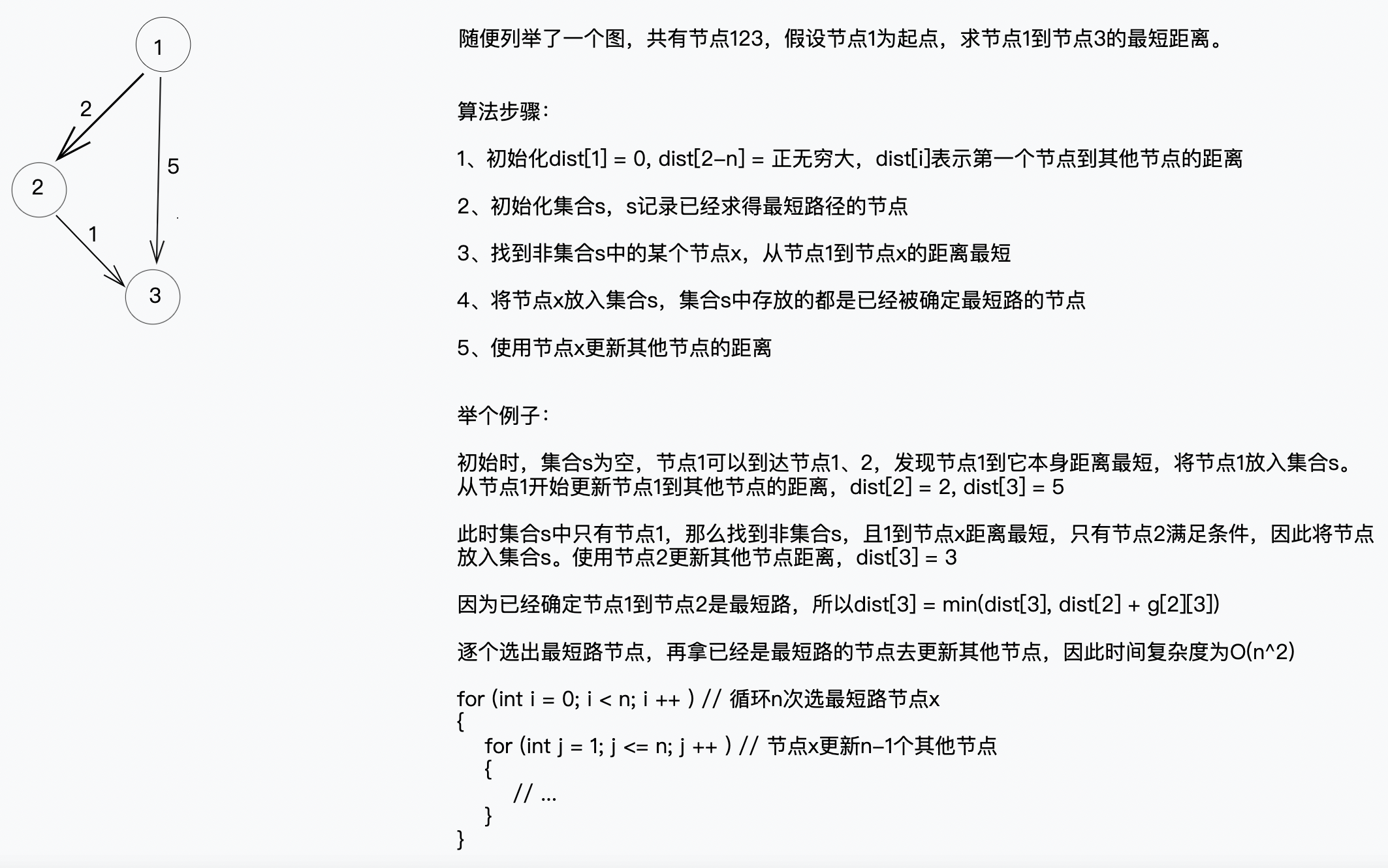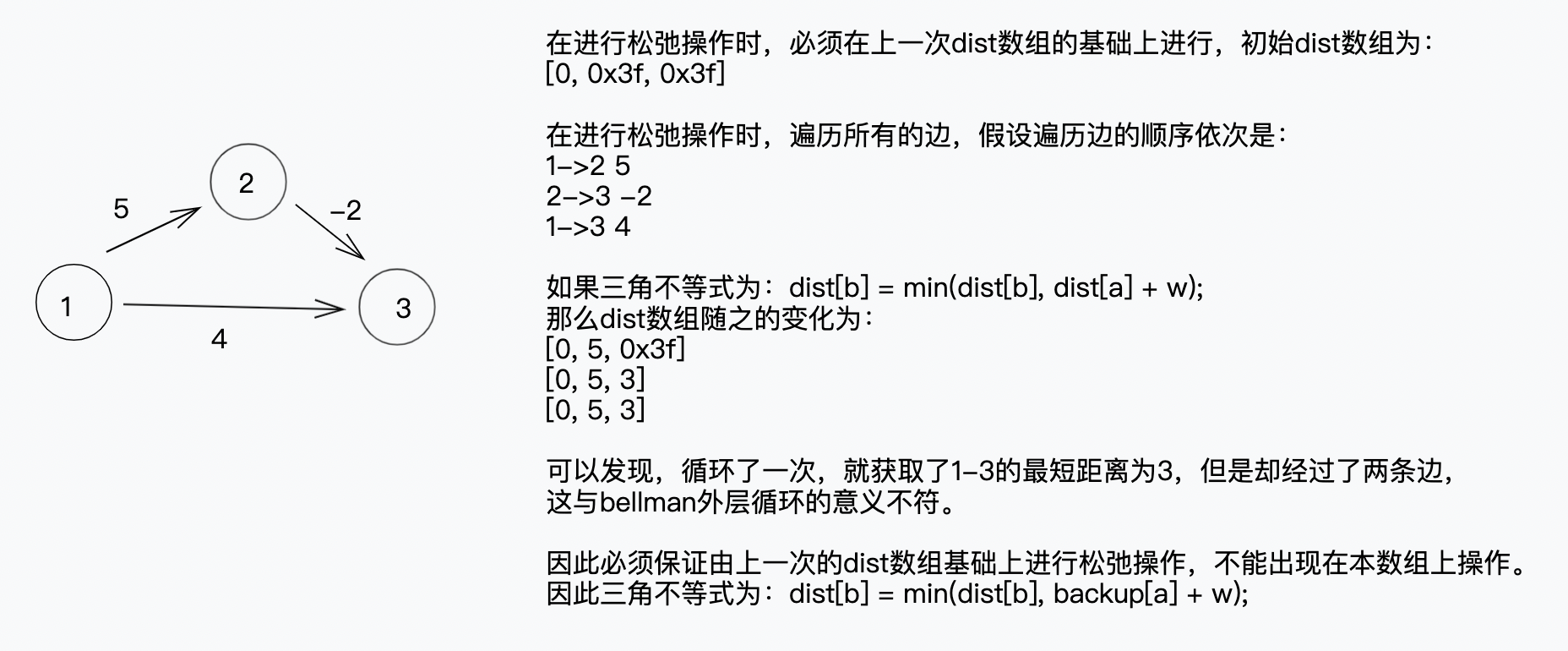求最短路
在图论中,求最短路是常见问题,往往求最短路问题存在很多限制,这使得我们需要根据限制在算法上找到最优解,因此不同的最短路算法用于求不同问题。
源指起点,汇指终点。n表示节点个数,m表示边的个数。

朴素Dijkstra

例题:https://www.acwing.com/problem/content/851/
#include <iostream>
#include <cstring>
using namespace std;
const int N = 510;
int g[N][N], dist[N];
bool st[N];
int n, m;
void dijkstra() {
// 初始化dist
memset(dist, 0x3f, sizeof dist);
dist[1] = 0;
for (int i = 0; i < n; i ++ ) {
// 从非集合st中取出最近节点x
int x = 0;
for (int j = 1; j <= n; j ++ ) {
if (!st[j] && (x == 0 || dist[x] > dist[j])) x = j;
}
// 将节点x放入集合s
st[x] = true;
// 使用节点x更新其他节点
for (int i = 1; i <= n; i ++ ) {
dist[i] = min(dist[i], dist[x] + g[x][i]);
}
}
if (dist[n] == 0x3f3f3f3f) printf("-1");
else printf("%d", dist[n]);
}
int main() {
scanf("%d%d", &n, &m);
memset(g, 0x3f, sizeof g);
while (m -- ) {
int a, b, c;
scanf("%d%d%d", &a, &b, &c);
g[a][b] = min(g[a][b], c);
}
dijkstra();
return 0;
}
堆优化版的Dijkstra
例题:https://www.acwing.com/problem/content/description/852/
在朴素的dijkstra算法中,寻找非s集合中,距离1最近的点,这个过程可以使用小根堆的特性进行优化。在找离1最近的点这个过程中,无需和所有的点进行比较,因为有些点目前是无法达到的,只需要和能达到的点比较,因此heap中存放的都是1可到达的点。
#include <iostream>
#include <queue>
#include <vector>
#include <cstring>
#include <algorithm>
using namespace std;
typedef pair<int, int> PII;
const int N = 150010;
int h[N], e[N], ne[N], idx, w[N], dist[N];
bool st[N];
int n, m;
void add(int a, int b, int c) {
e[idx] = b, w[idx] = c, ne[idx] = h[a], h[a] = idx ++ ;
}
int dijkstra() {
memset(dist, 0x3f, sizeof dist);
dist[1] = 0;
// 堆中存放的都是节点1的可达节点,并且根据1到可达节点的距离进行排序
priority_queue<PII, vector<PII>, greater<PII>> heap;
heap.push({0, 1});
while (heap.size()) {
// 在未确定距离的点集合中,找到距离1最小的点
auto t = heap.top();
heap.pop();
int v = t.second, d = t.first;
// 去重优化。由于点与点存在多条边,那么在heap中会存在距离不同但是点相同的重复数据,
// 由于heap已经按距离进行了排序,因此距离较大的点无需再用来更新其他点距离
if (st[v]) continue;
st[v] = true;
for (int i = h[v]; i != -1; i = ne[i]) {
int j = e[i];
// d是1到v的距离,w[i]是v到j的距离,dist[j]是1到j的距离
if (dist[j] > d + w[i]) {
dist[j] = d + w[i];
heap.push({dist[j], j});
}
}
}
if (dist[n] == 0x3f3f3f3f) return -1;
else return dist[n];
}
int main() {
scanf("%d%d", &n, &m);
memset(h, -1, sizeof h);
while (m -- ) {
int a, b, c;
scanf("%d%d%d", &a, &b, &c);
add(a, b, c);
}
printf("%d\n", dijkstra());
return 0;
}
该算法会遍历到所有点的的边,并且由于进行了去重,重复点只会遍历一次,因为外层for循环是O(m)的时间,内层heap push是O(logn)的时间,总体上是mlogn。
当n=m^2 时(稀疏图),mlogn=2m^2 ,时间复杂度为O(m^2 ),会比朴素算法的O(n^2 )快很多。
总体来看,Dijkstra本质就是用一个已经确定为最短路径的点,去更新其他点到源的距离。
dijkstra不能解决负权边问题,由于我们必须确定一个已知的对短路径,因此当图中出现负权边时,会导致我们选择的最短路径在之后的更新中变得更短,如下图:

Bellman-Ford
bellman算法的思想核心也和Dijkstra一样,使用一个点更新其他点到源的距离,即所谓的松弛操作,dist[b] = min(dist[b], dist[a] + w);
只不过bellman类似于暴力的解法,循环n次,每次循环中遍历所有的边,并进行松弛操作。外层n次循环是有实际意义的,循环k次表明从源到某节点的最短距离经过的边数不超过k条。 因此bellman算法可以专门针对对路径边数有限制的题目。
例题:https://www.acwing.com/problem/content/855/
#include <iostream>
#include <cstring>
using namespace std;
const int N = 510, M = 10010;
// 存储边,a为起点,b为终点,w为权重
struct Edge {
int a, b, w;
} Edge[M];
int dist[N], backup[N], n, m, k;
void bellman_ford() {
memset(dist, 0x3f, sizeof dist);
dist[1] = 0;
for (int i = 0; i < k; i ++ ) {
// 将dist进行备份,备份的原因是在松弛操作中可能会导致dist[i]被覆盖
memcpy(backup, dist, sizeof dist);
for (int i = 0; i < m; i ++ ) {
int a = Edge[i].a, b = Edge[i].b, w = Edge[i].w;
dist[b] = min(dist[b], backup[a] + w); // 松弛操作
}
}
// 松弛操作中,可能会对权重为0x3f的边削减一部分值,因此不能认为不可到达的距离一定是0x3f
if (dist[n] > 0x3f3f3f3f / 2) printf("impossible");
else printf("%d", dist[n]);
}
int main() {
scanf("%d%d%d", &n, &m, &k);
for (int i = 0; i < m; i ++ ) {
int a, b, w;
scanf("%d%d%d", &a, &b, &w);
Edge[i] = {a, b, w};
}
bellman_ford();
return 0;
}
针对注释做进一步解释:
1、memcpy(backup, dist, sizeof dist);

2、if (dist[n] > 0x3f3f3f3f / 2) printf("impossible");

bellman算法的时间复杂度为O(mn)。另外,bellman算法可以应对负权环(当图中出现一个环,并且环上的权重和为负数,就称之为负权环)在求最短路问题中,在负权环后边的点的距离将被视为无穷小,因为我们可以一直循环负权环让距离减小。bellman算法可以通过限制经过的边数,保证不陷于循环在负权环中。
SPFA
spfs算法是bellman算法的优化。在bellman算法中,暴力的将所有的边都进行松弛,但是有的点已经确定了最小距离,不在需要进行松弛。spfa就是针对该公式进行了优化dist[b] = min(dist[b], backup[a] + w);,只有dist[b]变小,对b周围的节点的更新才有意义。这和堆优化的Dijkstra有相似之处,只不过不需要挑出最小距离。
spfa算法不能处理存在负环的情况,且时间复杂度不够稳定,最坏为O(nm)。但是在99%的情况下,spfa都可以解决最短路问题,如果被卡,就需要换用上面其他算法。
例题:https://www.acwing.com/problem/content/description/853/
#include <iostream>
#include <cstring>
#include <queue>
using namespace std;
const int N = 100010;
int n, m;
int h[N], e[N], ne[N], w[N], idx;
int dist[N], st[N]; // st数组记录节点是否已经存在于队列中
void add(int a, int b, int c) {
e[idx] = b, w[idx] = c, ne[idx] = h[a], h[a] = idx ++ ;
}
void spfa() {
// 初始化
memset(dist, 0x3f, sizeof dist);
dist[1] = 0;
queue<int> q;
q.push(1);
st[1] = true;
while (q.size()) {
int t = q.front();
q.pop();
st[t] = false;
// 将可更新且不存在于队列中的点入队
for (int i = h[t]; i != -1; i = ne[i]) {
int j = e[i];
if (dist[j] > dist[t] + w[i]) {
dist[j] = dist[t] + w[i];
if (!st[j]) {
q.push(j);
st[j] = true;
}
}
}
}
if (dist[n] == 0x3f3f3f3f) printf("impossible");
else printf("%d", dist[n]);
}
int main() {
scanf("%d%d", &n, &m);
memset(h, -1, sizeof h);
while (m -- ) {
int a, b, w;
scanf("%d%d%d", &a, &b, &w);
add(a, b, w);
}
spfa();
return 0;
}
SPFA求负环
spfa算法在求最短路的基础上,可以增加一些字段来记录源到其他节点经过的边数。由于spfa求最短路会因为负环的存在,而一直循环于负环中(路径越来越长,但是距离越来越短),因此我们可以同时记录经过的边数,当边数大于等于节点个数,则可认为存在负环。
例题:https://www.acwing.com/problem/content/854/
#include <iostream>
#include <cstring>
#include <queue>
using namespace std;
const int N = 2010, M = 10010;
int n, m;
int h[N], e[M], ne[M], w[M], idx;
int dist[N], st[N], cnt[N]; // cnt数组表示1到其他点的最短路径上经过的边数
void add(int a, int b, int c) {
e[idx] = b, w[idx] = c, ne[idx] = h[a], h[a] = idx ++ ;
}
bool spfa() {
memset(dist, 0x3f, sizeof dist);
dist[1] = 0;
queue<int> q;
// 求整个图中的负环(而不是1-n路径上的负环)需要将所有点都作为源入队
for (int i = 1; i <= n; i ++ ) {
q.push(i);
st[i] = true;
}
while (q.size()) {
int t = q.front();
q.pop();
st[t] = false;
for (int i = h[t]; i != -1; i = ne[i]) {
int j = e[i];
if (dist[j] > dist[t] + w[i]) {
dist[j] = dist[t] + w[i];
// n个节点的图中求最短路,没有负环时最多经过n-1条边,当超过n-1条边,则表示有负环
cnt[j] = cnt[t] + 1;
if (cnt[j] >= n) return true;
if (!st[j]) {
q.push(j);
st[j] = true;
}
}
}
}
return false;
}
int main() {
scanf("%d%d", &n, &m);
memset(h, -1, sizeof h);
while (m -- ) {
int a, b, w;
scanf("%d%d%d", &a, &b, &w);
add(a, b, w);
}
if (spfa()) printf("Yes");
else printf("No");
return 0;
}
Floyd
floyd基于动态规划可求出任意源汇之间的最短距离。代码比较简单,好背。
例题:https://www.acwing.com/problem/content/856/
#include <iostream>
#include <algorithm>
using namespace std;
const int N = 210;
int d[N][N]; // d[i][j]表示节点i到节点j的最短距离
int n, m, q;
void floyd() {
for (int k = 1; k <= n; k ++ )
for (int i = 1; i <= n; i ++ )
for (int j = 1; j <= n; j ++ )
d[i][j] = min(d[i][j], d[i][k] + d[k][j]);
}
int main() {
scanf("%d%d%d", &n, &m, &q);
for (int i = 0; i < N; i ++ ) {
for (int j = 0; j < N; j ++ ) {
if (i == j) d[i][j] = 0;
else d[i][j] = 0x3f3f3f3f;
}
}
while (m -- ) {
int a, b, w;
scanf("%d%d%d", &a, &b, &w);
d[a][b] = min(d[a][b], w);
}
floyd();
while (q -- ) {
int a, b;
scanf("%d%d", &a, &b);
if (d[a][b] > 0x3f3f3f3f / 2) printf("impossible\n");
else printf("%d\n", d[a][b]);
}
return 0;
}

